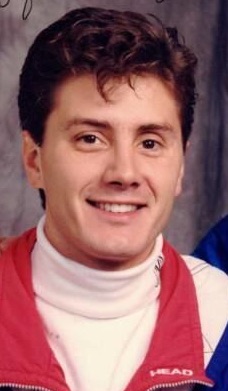
Sport: Figure Skating
Born: November 11, 1965
Town: Trenton, New Jersey
Rocco L. Marvaldi was born November 11, 1965 in Trenton, NJ, to Sharon and Lawrence Marvaldi, whose family had been in the meat packing business since the turn of the century. “Rocky” had an older brother, Lawrence, Jr. who later became his partner in a trucking business in New Egypt. Rocky played baseball in the summers but his dream was to become a world-class figure skater. He took his fair share of teasing from his private-school classmates for his winter hobby, but his greater frustration was a lack of quality instruction. The Marvaldis were refused membership in the skating clubs around Philadelphia and Wilmington where elite-level coaching was available because, as Rocky said often, they didn’t travel in the same social circles. This is the reason he eventually shortened his name to Marval.
Rocky’s skating days had nearly ended when he crashed his dirt bike a 70 mph and needed facial reconstruction surgery. Although he made a full recovery, he figured his best bet to move up the figure skating pecking order in the US was to specialize in pairs skating. In 1985, he skated in Wilmington for a few months with Calla Urbanski, an oft-injured, tough-talking 25-year-old divorcee from Chicago who was working in town as a cocktail waitress. Rocky thought they clicked on the ice—he was a strong, powerful 5’9” and she was a petite 4’11”—but his coach dissuaded him from pursuing the partnership. She was too old, he insisted.
In 1990, after Rocky split up with Maria Lako, his pairs partner/girlfriend, he and Urbanski began talking about reuniting as a team. She had gone through several partners—one of whom had dropped her on her head and another whom she had sliced with her skate to the tune of 170 stitches—and was no closer to her goal of making it to the Olympics than she had been in her prime a decade earlier. Rocky wasn’t exactly killing it, either. They decided to try to beat the odds together.
At first it looked like a match made in figure skating hell. She had trouble with the double axel and he tended to flinch when she got too close to his face. Rocky also had difficulty embracing the artistic, emotional side of the sport. He lost his temper easily and she pushed him all the time. They argued all the time, often on the ice, and were referred to as “the waitress and the truck driver.” That made it hard to land sponsors, but between their two blue-collar jobs and small donations, they managed to scrape up enough to cover their training.
In 1991, they entered the US Figure Skating Championships in Minneapolis. While the press obsessed over the triumvirate of Nancy Kerrigan, Kristi Yamaguchi and Tonya Harding, Rocky and Calla caught the attention of pairs fans when they logged an unexpectedly high fourth-place finish in the technical program. In the free skate, they blew the judges away to earn the top score. Not only had they won the silver medal, they were now part of the US team for the World Championships in Munich. They skated well against international competition, but finished far off the leaders in ninth place.
Early in 1992, Rocky and Calla returned to the US Championships, this time held in Orlando, to prove 1991 wasn’t a fluke. With Olympic qualifying also on the table, the competition was being billed as “The Road to Albertville.” Who better than a trucker and a waitress, some joked, to feel at home on that road?
Rocky and Calla performed very well in the technical skate, finishing third, behind reigning champs Todd Sand and Natasha Kuchiki. Another silver medal was definitely within their grasp. In the free skate, the two were absolutely electric. Calla came out of her throw triple-loop perfectly with a huge smile on her face and they killed it the rest of the way. By the time Rocky and Calla finished, there was little question who would win the gold.
The perfect end to this story would have been an Olympic medal. But their lack of time skating together showed and they finished 10th. Rocky and Calla successfully defended their US title in 1993 but finished 8th at the World Championships that winter. Calla blamed Rocky for their poor performance and their constant squabbling became too much for both of them to bear and they split up—“before they wound up punching each other out on center ice,” as sportswriter George Vecsey famously said. With a scheduling quirk making 1994 an Olympic year, neither skater had time to find an ideal partner and both failed to qualify for the competition in Lillehammer.
Perhaps their happy ending came later in 1994, when they reunited on the professional tour and enjoyed renewed success as figure skating’s ultimate Odd Couple throughout the mid-1990s. Both are coaches today, with Rocky Director of Skating at The Igloo in Mt. Laurel.